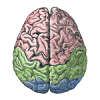8.4: Priming- Weight and Activation-Based
- Page ID
- 12612
Moving further afield from the hippocampus and surrounding cortical areas (e.g., the familiarity signal in the perirhinal cortex), can perceptual and other association cortex areas make useful memory contributions based on single or small numbers of exposures? The answer here is also in the affirmative, but unlike the familiarity signal, these memory traces remain almost entirely below the radar of conscious awareness -- scientists can measure memory effects in terms of various behavioral measures, but we are not subjectively aware of having these memories. The general term for this form of memory is priming, because the main behavioral manifestation is a speedup in reaction time, or an increased probability of making a particular behavioral response -- as if the "pump is being primed" by these memory traces. Indeed, we think of the slow incremental neocortical learning effects as doing exactly this pump priming level of tweaking to the underlying neural representations. Only sustained changes over many experiences can truly reshape these more stable neural representations in more dramatic ways. And as we get older, it seems that perhaps the learning rate gets slower, making it even more difficult to fundamentally reshape the most basic neocortical representations.
In addition to the subtle effects of slow learning changes, priming can also result from residual activation -- neural firing that persists from previously processed information. Thus, we can distinguish between weight-based priming and activation-based priming. As might be expected, activation-based priming is very short-lived, disappearing as soon as the neural firing dissipates. By contrast, weight-based priming can be remarkably persistent, with some cases of priming lasting a year or more, from a single exposure! This kind of behavioral result puts strong constraints on the stability of synaptic plasticity -- various computational models introduce forms of synaptic weight decay, but this seems inconsistent with the extreme durability of priming, and of our long-term memories more generally.
One behavioral paradigm used to reveal priming effects is called stem completion. Here, the first letters of a word are presented, and the participant is asked to complete the stem with the first word that comes to mind. For example, you might see stems like this:
\(\begin{array}{l}{\text { win___ }} \\ {\text { let___ }}\end{array}\)
and respond with words like "window" or "winter", "letter" or "lettuce". The priming effect is revealed by first exposing people to one of the possible words for these stems, often in a fairly disguised, incidental manner, and then comparing how much this influences the subsequent likelihood of completing the stem with it. By randomizing which of the different words people are exposed to, you can isolate the effects of prior exposure relative to whatever baseline preferences people might otherwise have. We know that those priming effects are not due to learning in the hippocampus, because they remain intact in people with hippocampal lesions.
Exploration
Now we can explore both weight-based and activation-based priming on a simple stem-completion like task, using a very generic cortical learning model.
- WtPriming (wt_priming.proj)
- ActPriming (act_priming.proj)


